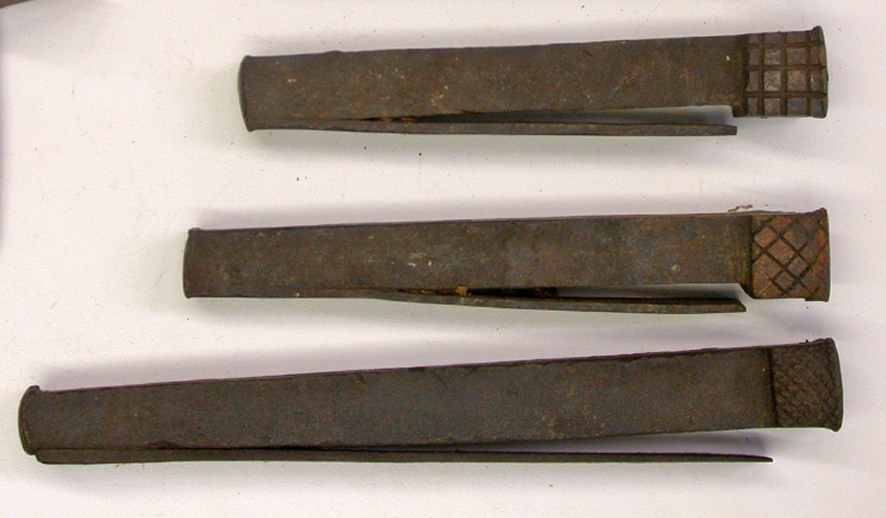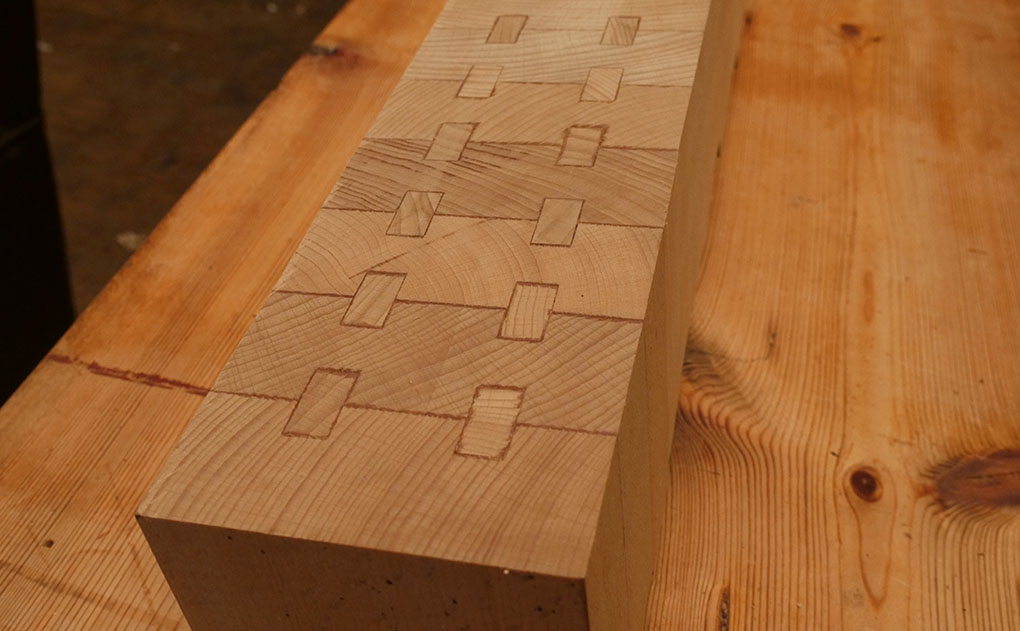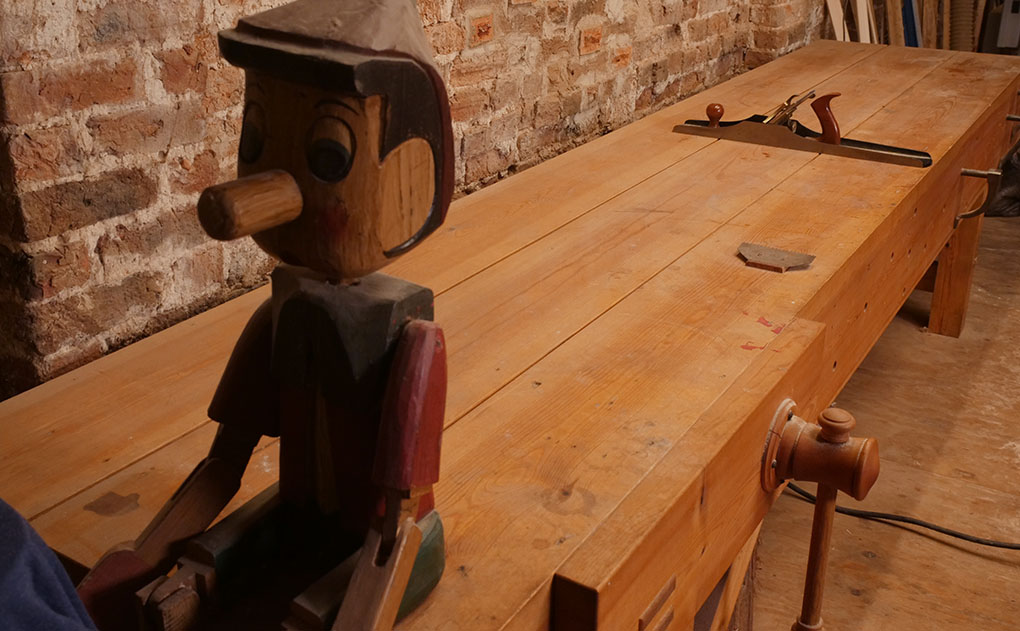A couple of weeks ago I wrote about my preferences when it comes to the shape of a bench dog and now I’m going to elaborate a little and cover some points about the choice of material.
I’d thought about comparing the options with a list of pros and cons but then realised this doesn’t really weight them in terms of importance and makes for a pretty obvious and barely helpful post. Instead I’ll just babble a bit about my thoughts and who knows, perhaps you’ll be better placed for making your choice.
Always keep in mind that bench dogs of both metal and wood are used daily and each has there fans so whichever way you decide to go you can’t go too far wrong.
Since I supply a pair of dogs with each of my workbenches I suppose that must give some indication to my preference – I always supply metal. My reason for this: with anything that I send out to my customers I want to be confident that it will last well.
Secondly I can purchase metal dogs but can’t purchase wooden. After building a workbench knocking up a couple of dogs is hardly the most challenging part and since I need a lot they could be made quickly and in a huge batch. This would add another process for me though and if I can buy something that lasts much better then metal has become my obvious choice.
So metal dogs can be bought and there’s no reason they won’t last a lifetime – that ticks the boxes for me. But what if you only need a couple for yourself and really don’t mind spending the time to replace them every now and then – well then wooden dogs will save you some money and that can only be good! If you make your own bench dogs then you have the ability to make them as long or as short as you need to suit your top thickness and this can be especially useful if your top is upwards of 4” thick.
Of course the other reason that many people opt for wooden dogs is because they fear putting a lump of steel in the path of their plane blade and this is a very valid point! If you accidentally pelt your plane in to a steel dog then you could find yourself in need of a good long sharpening session or worse. I should add that in all the time that I’ve hand flattened boards I’ve never (yet) hit a dog. Dogs will support the work without needing to raise them close to the top of the board so if you’re mindful of the dog height there’s no reason you should ever hit one. As a beginner though you’re perhaps more prone to hitting a dog until the habit of checking sets in.
It’s important to note that I opt for brass bench dogs – this acknowledges this issue since the soft metal would come off worse if you hit it and a quick touch up at the sharpening stones would rectify any damage done.
Ultimately there’s no clear cut answer but I hope you’ll find my thought’s useful. Just to finish up I’ll add an historic perspective. Square, steel bench dogs used to be the most common since years ago hardware would generally be made at the forge and hammering a nice fitting square dog would have been easiest. Since craftsmen earned their living at their bench it was all about pace and when you’re doing a lot of planing a wooden dog might not last too long so steel it was. It isn’t hitting a dog that would likely ruin it but if you plane aggressively and hit a big knot then the action will jar and if a dog isn’t holding tight enough the board could twist and result in splitting a wooden dog.


![Simple Work Holding For Ploughing Grooves [Without a Tail Vice]](https://www.theenglishwoodworker.com/wp-content/uploads/2022/07/workholding-without-tail-vice-copy.jpg)
![Gluing Up A Workbench Leg [VIDEO]](https://www.theenglishwoodworker.com/wp-content/uploads/2022/06/gluing-up-a-workbench-leg-video.jpg)


And the Veritas round dogs that you use are the dog’s whatsits!!
It will be Veritas round dogs for me. Nice post Richard thanks 😉
Not a comment although I use steel dogs. I am interested in buying one of the parallel rod assemblies for a face vise that I already have. I sent an email a week or so ago to ask if you had decided whether or not to sell the rod and bushing separate from the vise set that you offer. I would like to hear your decision and, if you decide to go ahead and sell the rod and bushing separately, what the cost and shipping fees will be. Thank you. I enjoy your emails and website.
Hi Tom, Sorry about that, it seems that your email hasn’t come through, would you be able to resend it? We are certainly looking to make the shaft system available on its own and will be bringing a blog post with all of the details shortly.
Richard
A very “in depth” review of our much used Bench Dog,where would we be without them? As for striking the Dog with your Plane,I have never even considered that one could do this,as you say,the properly set Dog will hold under the most strenuous of uses,they should never peek up above the piece being planed,the only time this could happen is if one used one of those electrical planes which took off 2mm at a time!! But we would not be useing one of those,would we!
Chris,
France.
Hi Richard and Friends,
The subject of bench dogs is an interesting one for me… having spent quite some time at the bench during my apprenticeship (1970 -1975) from the tender age of fifteen… Earning a weekly wage of £3-17s 6d!, I recall that bench dogs were never included on any of the four 10ft – 12ft long benches we had in the joiners shop – rather than bench dogs, a piece of timber was fixed to the leg of the bench and it protruded through a mortise cut in the bench top. One tapped the timber up through the mortise to the desired height to use as a stop. A piece of timber would be nailed… cringe! .. at the opposite end of the timber to be held in order to work it as required. This was usually to run a moulding using wooden moulding planes of varying types. I just could not imagine banging a nail into one of your bench tops Richard!
It is very interesting also to note that at the time of my apprenticeship the workshop machinery comprised a Wadkin 24” planer, a Wadkin thicknesser, A Rip saw, A small Bandsaw, a hand router and a Wadkin mortise machine. All other operations were completed by hand including all drilling!
I wondered if you could throw any light on when bench dogs came into use? I would also be interested to know a little about the bench end vice (vise?) as again, our workshop benches did not have these. The benches were of the type which had the central ‘well hole’ comprising 4×9” wide timbers, the outer two being 3” thickness, the inner two usually 1 1/2”. I am guessing that bench design may have varied and been dependant upon geographical location?
Thanks so much for a very interesting site and range of discussion topics. Many fond memories have been re-kindled since finding your site. Perhaps I’ll have the opportunity to relate one or two in the future 🙂 Sorry if I have digressed a little from the original discussion topic! Brass bench dogs do add a little touch of class!
Jeff
Kent UK
Thanks Jeff for such an interesting comment. A wooden bench stop like the sort in your workbenches would have been used long before a tail vice came along and they were often sufficient to be used on their own, some versions were metal with ‘spikes’ that would give better hold on the work.
Bench dogs probably came along to accompany a tail vice and these were one of the later developments in bench design. They didn’t become essential to many woodworkers so a lot of benches were built without them even long after they were introduced.
Our Wadkin line shaft machines will give us a very similar set up to what you had! A great story and thanks again for sharing.
All the best, Richard
I make my own dogs of wood. Its cheaper and uses scraps, but more importantly, I can make enough to place one in every hole. This makes life easy for a while. Then, when I’m down to two or three, I make a new batch.
This is particularly useful with young children, who love to commandeer the things for their own play.
I don’t bother fastening the wooden spring with a screw, just let it into a curved slot with a little glue. These hold up pretty well, if made from stout wood. I use maple or locust. I have never split one, nor have I ever chipped a plane blade. The only thing I sometimes do is fit a new spring.
Thanks Jason, that’s a great addition to the discussion. Filling every hole with a bench dog can be very handy and would certainly get expensive if they were all brass!
Richard
I’m interested in purchasing a pair of vintage metal bench dogs. Any help in locating a pair or if you have a pair for sale…………..
Hi. I’ve just found your site, and I look forward to even more happy hours “wasted” on the computer 🙂
I’m just embarking on building a wall-mounted general-purpose workbench, using salvaged 60mm scaffold boards. It’s in a basement with limited head height, narrow doors, and an RSJ running across the centre, so options are limited!
I’ve only recently heard of bench dogs and holddowns, so am totally sold on the benefits, and so want to include suitable holes, but I’m unsure what diameter they should be – as far as I can see so far there are 19mm, 20mm, and 1″ dogs on the market! What is the most sensible diameter to use for a UK workbench working on a budget? And is there a suitable drill guide/bushing to make drilling easier/more accurate? I want to keep things as “standard” as I can to maximise flexibility. Any comments or suggestions appreciated.
Hi Niall,
I would definitely go 19mm for your holes – that would be the most versatile. And to drill them square try this, https://www.theenglishwoodworker.com/cant-see-straight/ (sorry, it’s a rather old post!)
Great – thanks for the response and suggestion.
I own an electric drill and grinder all my tools ,which are many, are hand tools including 1878 wood planes. I am looking at the iron dogs in your video of end vices. Id think I can make them as her in Latvia no such thing exists.